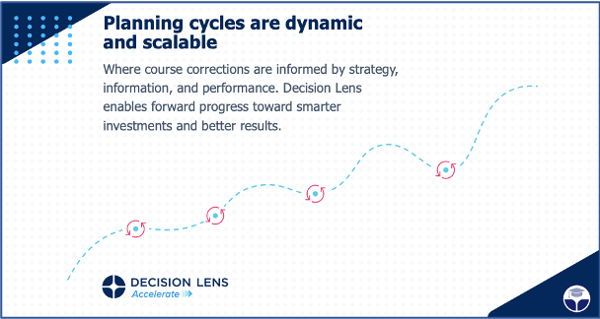In this article
Organizations are constantly trying to find ways to plan better. And whether in a government or commercial organization, we know that past planning methods no longer keep up with existing demands.
(For more on this, see our recent blog post about planning in a virtual world.)
A continuous planning solution, including the correct processes and tools, is required.
The best decision-makers of our day have the ability to see planning through execution. They always maintain visibility between the projects and a line of site to the strategy, with a continuous improvement loop connecting what is actually happening with the new and ongoing plan.

While processes and organizations vary to some degree, generally, the link from planning to execution begins with a requirements gathering process. Requests for funding come in from different corners of the organization (or outside of the organization) along with some information about those requirements.
If done properly, those requirements should be informed by both existing capabilities and projects as well as the strategic drivers that point resources in the right direction. The best organizations not only ask stakeholders what they need, but also give them a rubric (or criteria) so they can request what will drive the strategy.
Once the requirements are pulled together, they are usually vetted (with the data validated) through some sort of filtering process. One of the major hurdles here is simply gathering the information in one place.
With manual spreadsheets, the process can require significant effort and take a hit in accuracy. An automated solution to house the data is advisable. And with an automated solution, an unfunded requirement from last year can move forward and “live” in the solution, all the way through the execution of a fully developed project.
The vetting process should not only filter out the unaligned or infeasible requirements, but it should also prioritize the requirements moving forward as they change from requirements to projects. Prioritization can be done in many ways, from a simple ranking to a more sophisticated criteria-based process.
When all is said and done, the ranking should reflect the priorities of the organization. An important link between planning and execution is to not only estimate the value of a project, but to see whether that value was realized through the execution of a project. Again, an automated solution can help to compare the estimated benefit to the actual value, informing new requirements going forward.
Finally, resources need to be attached to these requirements. Usually this is done when the requirements are first submitted, but they could be added at any point in the process.
In the estimation of resources, perfect can definitely become the enemy of good. Cost or estimates will never be perfectly accurate, but should provide enough understanding to make relative judgments about which projects to go after and the relative value (benefit) return on the investment (cost) you plan to make.
In the allocation of resources, the planning aspect should never be very far removed from execution, as you move ahead with projects and realize the true costs. Your planning will get smarter and smarter as it incorporates the actuals.
More sophisticated tools, such as Decision Lens, can also help planners allocate resources through advanced optimization techniques and schedule out resources by highlighting bottlenecks over a period of time.
At the end of the day, you can boil the objectives of the process down to two questions: What should we fund to further our strategy? When should we fund these requirements?
The key in all of this is to plan with an eye towards executing on the highest priorities, and execute with an eye towards better planning. This continuous cycle ensures a greater and ongoing line of sight to the strategy.
Do you have a similar issue that needs addressing? We’d love to help you change the way you’re viewing your problem by incorporating Decision Lens methodologies! Please reach out to a member of the Decision Lens team today - we’d love to chat with you!
Want to hear more? Check out our video as we continued this discussion live!






